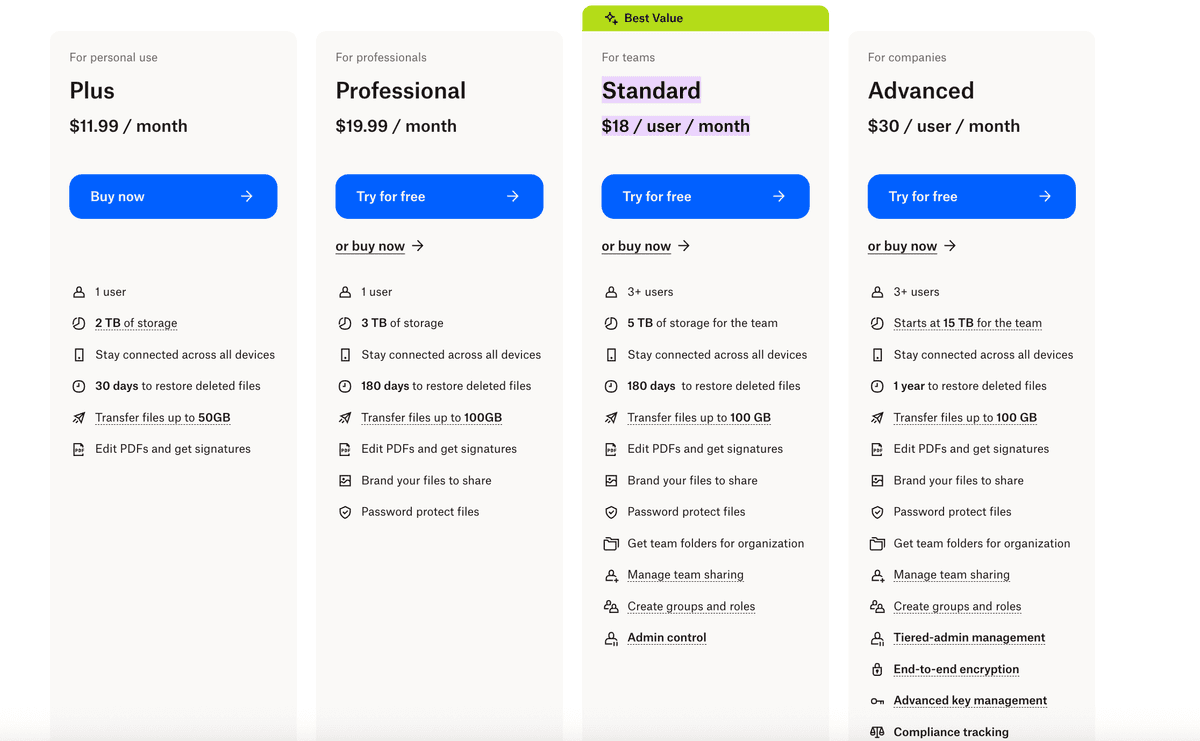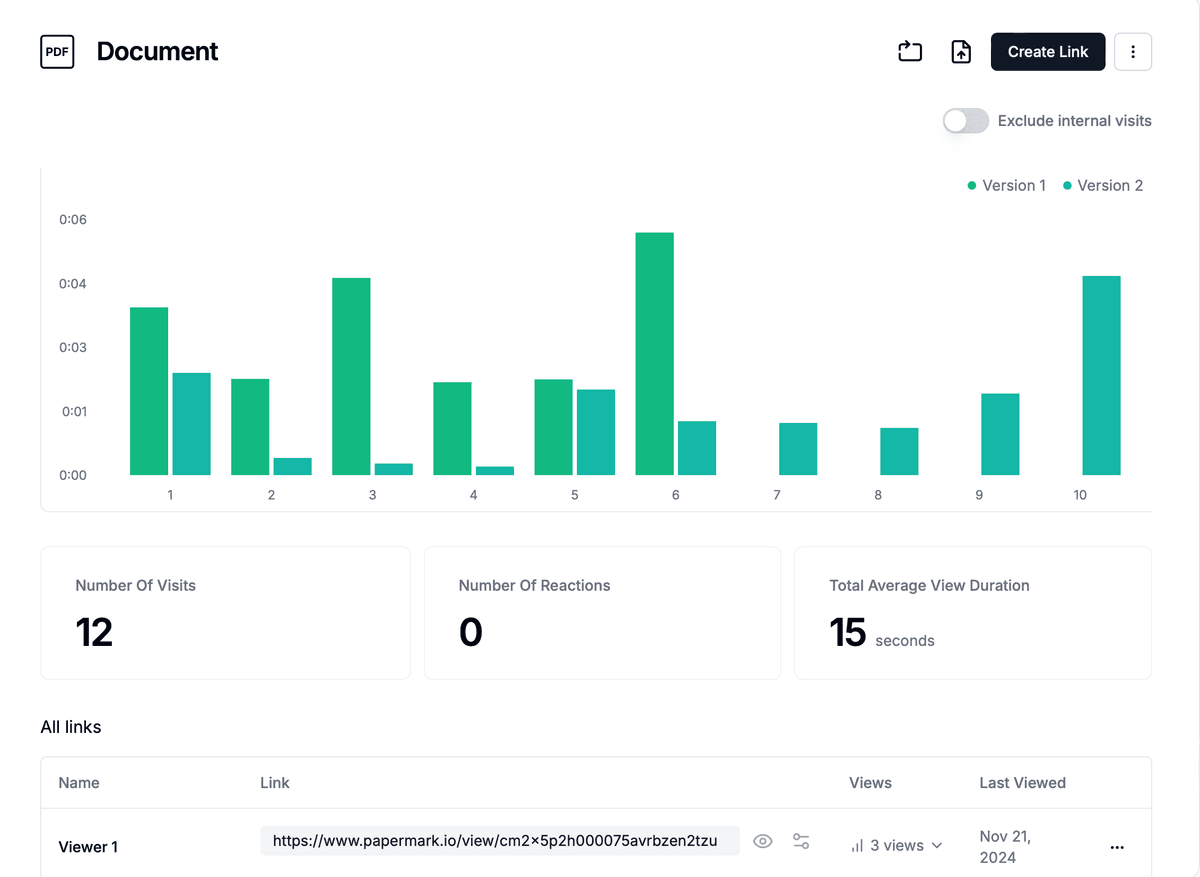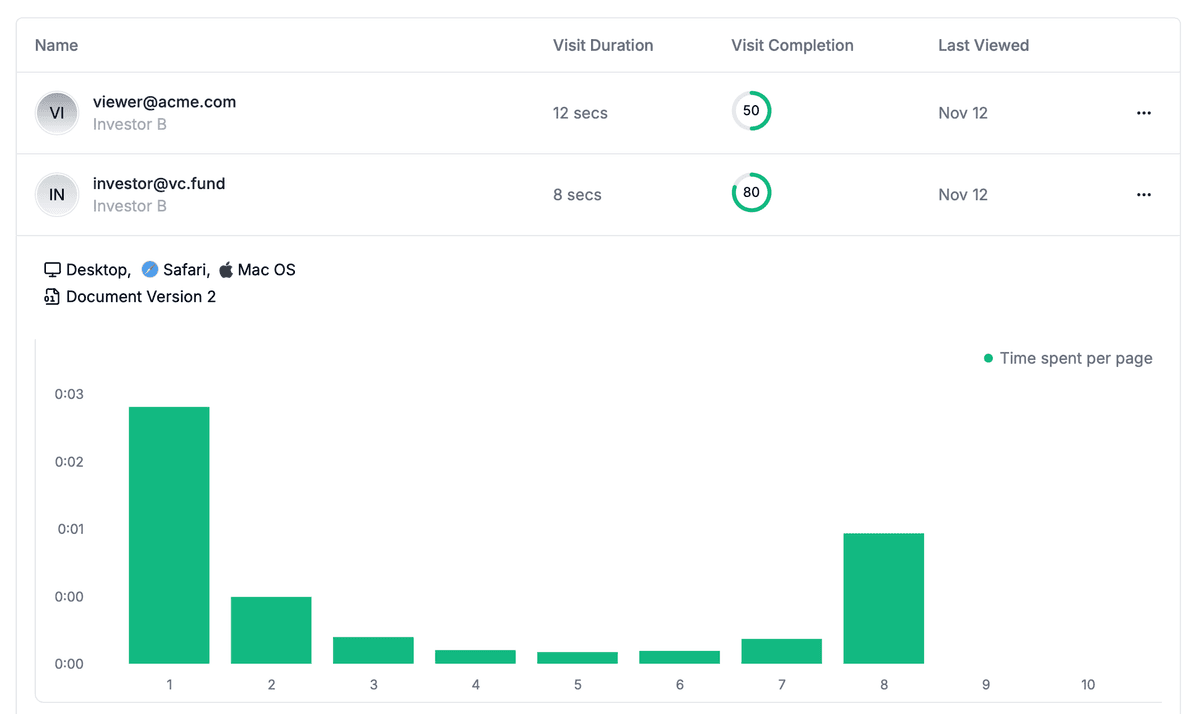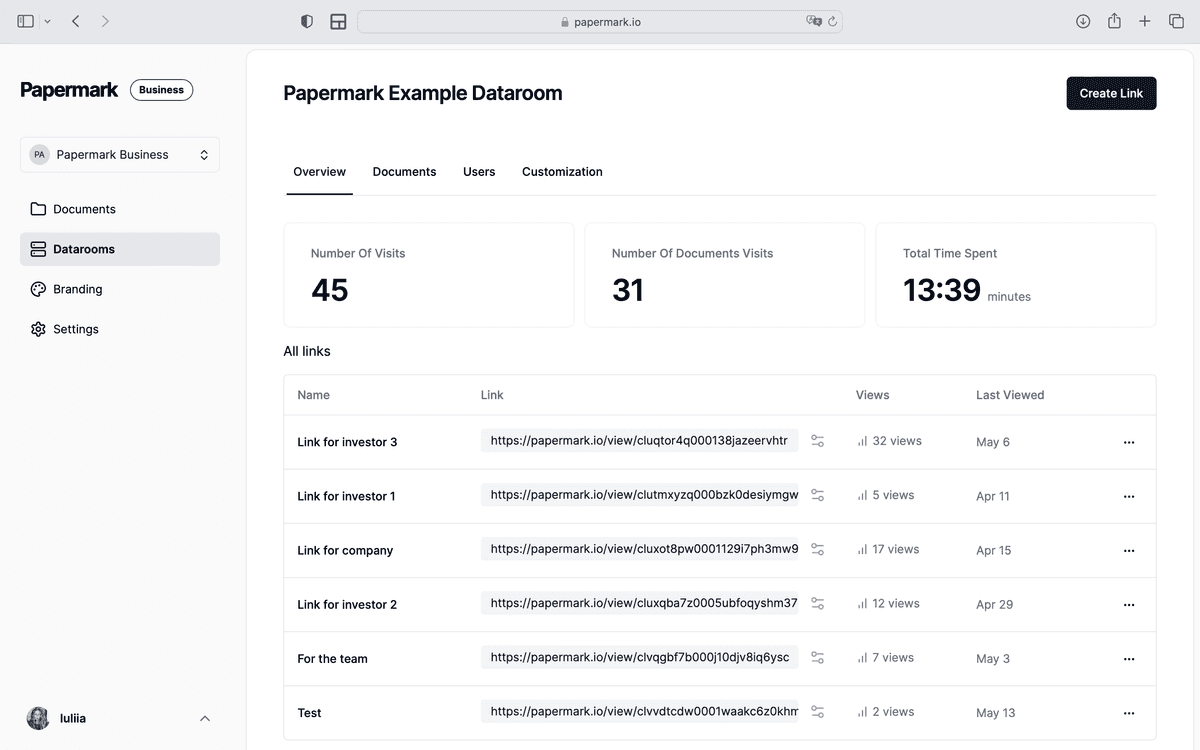Dropbox est un outil populaire de stockage de fichiers et de collaboration basé sur le cloud que de nombreuses entreprises utilisent pour le partage général de documents. Cependant, il est important de comprendre que Dropbox n'est pas conçu pour partager des documents sensibles lors des processus de due diligence, de levée de fonds et de fusions-acquisitions. Dans cet aperçu, nous explorerons ce que les capacités de Dropbox offrent réellement et comment elles se comparent aux solutions modernes de data room comme Papermark.

La data room Dropbox expliquée
Dropbox Data Room est une solution basée sur le cloud qui fournit un environnement de base pour le partage et la gestion de documents. Elle est conçue pour aider les équipes à organiser et partager des documents via une interface Dropbox familière, bien qu'elle manque de nombreuses fonctionnalités de niveau entreprise que l'on trouve dans les solutions de data room dédiées.
Remarque : En 2021, Dropbox a acquis DocSend, qui est maintenant leur produit dédié au partage sécurisé de fichiers pour les transactions commerciales sensibles. Cependant, cet article se concentre sur les capacités de la plateforme principale de Dropbox plutôt que sur les fonctionnalités spécialisées de DocSend.
Quand utiliser chaque plateforme :
-
Utilisez DocSend si vous souhaitez contrôler, suivre et mettre à jour les versions de documents destinés à l'externe comme les présentations pour investisseurs, les propositions clients ou les fichiers confidentiels. Pour des informations détaillées sur les tarifs de DocSend et ses fonctionnalités, consultez notre guide complet.
-
Utilisez Dropbox si vous recherchez du stockage, des sauvegardes et un large partage/collaboration de fichiers sans besoin d'analyses détaillées des consultations. Pour une comparaison des fonctionnalités et des prix de Box vs Dropbox, explorez notre analyse détaillée.
Fonctionnalités clés de la data room Dropbox
Organisation et gestion des documents
Dropbox fournit des outils de base pour organiser les documents sensibles :
- Structure hiérarchique de dossiers pour une organisation logique
- Capacités de téléchargement en masse pour la gestion documentaire
- Contrôle de version pour suivre les modifications de documents (30-180 jours)
- Autorisations de partage basiques
- Fonctionnalités limitées de protection des documents
L'interface familière de Dropbox permet aux utilisateurs de naviguer facilement à travers les documents, tandis que les outils d'organisation de base aident à maintenir une approche structurée du partage de documents.
Sécurité et contrôle d'accès
Dropbox offre des fonctionnalités de sécurité fondamentales :
- Paramètres d'autorisation basiques (Afficher, Commenter, Modifier)
- Authentification à deux facteurs
- Partage de liens avec restrictions d'accès
- Liens protégés par mot de passe et expiration des liens
- Surveillance d'activité basique
- Capacités d'audit limitées
Bien que Dropbox fournisse des mesures de sécurité de base, de nombreux utilisateurs se demandent si Dropbox est sécurisé pour un usage professionnel. La réponse dépend de vos exigences spécifiques en matière de sécurité et de conformité.
Suivi d'activité et analytique
Dropbox fournit des informations limitées sur l'utilisation des documents :
- Surveillance d'activité basique
- Analytique simple des consultations
- Suivi des téléchargements
- Statistiques de partage basiques
- Capacités de reporting limitées
Tarification et disponibilité de la data room Dropbox
Dropbox est disponible avec plusieurs niveaux de tarification :
- Gratuit : 2 Go de stockage
- Plus : 12 $/utilisateur/mois (2 To de stockage)
- Professional : 20 $/mois (3 To de stockage)
- Standard : 18 $/utilisateur/mois (5 To de stockage)
- Advanced : 30 $/utilisateur/mois (stockage illimité)
Dropbox offre un essai gratuit de 30 jours sur les forfaits payants. Vous devez saisir vos coordonnées de paiement pour commencer l'essai, et vous serez automatiquement facturé pour un forfait complet une fois la période d'essai terminée, sauf si vous annulez au préalable.
Remarque : Pour obtenir les informations tarifaires les plus récentes, veuillez consulter le site officiel de Dropbox, car les prix et les forfaits peuvent évoluer avec le temps.

Comment utiliser Dropbox comme data room
L'utilisation de Dropbox comme data room est simple, mais gardez à l'esprit ses limitations pour les transactions sensibles ou à enjeux élevés. Voici un guide rapide :
- Organisez vos fichiers : Créez une structure de dossiers claire pour votre projet ou transaction. Utilisez des sous-dossiers pour différentes catégories de documents (ex. : juridique, financier, RH).
- Téléchargez des documents : Glissez-déposez des fichiers ou utilisez le bouton de téléchargement pour ajouter des documents dans les dossiers appropriés.
- Définissez les autorisations : Partagez des dossiers ou des fichiers avec des personnes spécifiques en saisissant leurs adresses e-mail. Choisissez le niveau d'accès approprié (visualisation, commentaire ou modification).
- Activez le partage de liens (si nécessaire) : Pour les parties externes, générez un lien partageable. Utilisez la protection par mot de passe et les dates d'expiration pour une sécurité accrue.
- Suivez l'activité : Utilisez le suivi d'activité de Dropbox pour surveiller qui a accédé aux fichiers ou les a modifiés, bien que les analyses soient basiques par rapport aux data rooms dédiées.
- Mise à jour et contrôle de version : Remplacez les fichiers obsolètes par de nouvelles versions pour maintenir votre data room à jour. Dropbox conserve un historique des versions pour chaque fichier.
Pour les transactions hautement confidentielles ou réglementées, envisagez une solution de data room virtuelle dédiée pour une sécurité, une conformité et des analyses avancées.
Data room Dropbox : limitations principales
Dropbox et autres plateformes populaires de stockage cloud ne sont pas des outils dédiés au partage d'informations confidentielles. Bien qu'ils fonctionnent bien pour la collaboration quotidienne en entreprise, ils ne répondent pas aux besoins spécifiques qui découlent des bonnes pratiques dans la conduite de procédures telles que les transactions et les audits.
La principale différence entre une VDR et les disques cloud populaires concerne la sécurité des informations stockées et les fonctionnalités. Bien que la VDR fonctionne également selon le modèle SaaS, elle se distingue des outils cloud populaires par des fonctions avancées de supervision du trafic et des caractéristiques permettant, par exemple, d'accélérer l'ensemble de la procédure.
Les principales limitations comprennent :
- Absence de structure transparente de dossiers et fichiers avec contrôle d'accès en un clic
- Rapports d'activité limités (pas d'informations détaillées sur qui, quand et pendant combien de temps a ouvert les fichiers)
- Pas de filigranes intégrés ni d'outils de rédaction
- Absence de verrouillage des captures d'écran ou de restrictions de téléchargement
- Pas d'antivirus intégré ni de fonctionnalités avancées de conformité
- N'importe qui possédant un lien peut accéder aux fichiers sans authentification appropriée
- Pas de chef de projet individuel ni de module Q&R dédié
- Le téléchargement maximal de fichiers pour le plan gratuit est de 2 Go (100 Go pour les plans payants)
- L'historique des versions est limité par rapport aux solutions de data room dédiées
Dropbox et les autres plateformes de stockage cloud ont accès au contenu de chaque document stocké sur leurs serveurs. Bien que cela ne signifie pas qu'ils portent atteinte à la vie privée, la conscience que les données peuvent être traitées à des fins marketing n'est pas idéale du point de vue des meilleures pratiques de confidentialité.
Pour les processus qui nécessitent un contrôle spécial sur les informations fournies, ces outils ne feront pas l'affaire. Lorsqu'il s'agit d'informations hautement confidentielles comme la propriété intellectuelle, les plans stratégiques de l'entreprise, les états financiers ou les investissements, une VDR dédiée garantit que les mesures de sécurité les plus élevées sont utilisées.
Bien que Dropbox vous permette de partager un dossier Dropbox avec des utilisateurs externes, cette fonctionnalité de partage basique manque des contrôles avancés et des fonctionnalités de sécurité requises pour les transactions commerciales sensibles.
Pourquoi considérer Papermark comme alternative ?
Papermark offre une solution complète de data room virtuelle avec des fonctionnalités avancées conçues pour le partage sécurisé de documents. La plateforme inclut un filigranage dynamique qui ajoute automatiquement les informations du lecteur aux documents, une protection par mot de passe pour un accès contrôlé et des politiques de sécurité complètes.

Analytiques détaillées page par page
Contrairement au suivi d'activité basique de Dropbox, Papermark offre des analytiques complètes qui fournissent des insights approfondis sur l'engagement des documents :
- Durée de consultation : Suivez exactement combien de temps les lecteurs passent sur chaque page
- Suivi page par page : Voyez quelles pages spécifiques reçoivent le plus d'attention
- Données géographiques : Comprenez d'où vos lecteurs accèdent au document
- Informations sur les appareils : Sachez quels appareils et navigateurs votre audience utilise
- Suivi des téléchargements : Surveillez quand les documents sont téléchargés
- Statut de signature des NDA : Suivez qui a signé les accords requis
- Données de champs personnalisés : Consultez les réponses aux questions personnalisées

Permissions de liens avancées et sécurité
Papermark offre un contrôle granulaire sur l'accès aux documents grâce à ses paramètres de liens complets :
- Vérification par email : Exigez que les lecteurs vérifient leur email avant d'accéder aux documents
- Listes d'autorisation/blocage : Créez des listes spécifiques de lecteurs autorisés ou bloqués
- Protection par mot de passe : Ajoutez une couche supplémentaire de sécurité avec des exigences de mot de passe
- Protection contre les captures d'écran : Empêchez les captures d'écran non autorisées de vos documents
- Exigences de NDA : Obligez les lecteurs à signer des NDA avant d'accéder à du contenu sensible
- Champs personnalisés : Collectez des informations supplémentaires auprès des lecteurs avant qu'ils n'accèdent aux documents
- Collecte de feedback : Recueillez des retours directs des lecteurs de documents

Pour les équipes qui ont besoin d'insights détaillés sur l'engagement, Papermark fournit des analytiques avancées qui suivent le comportement des lecteurs, le temps passé sur chaque page et des métriques d'engagement détaillées. La plateforme offre également :
- Salles de données et stockage illimités pour 99 €/mois
- Options de domaines personnalisés et de personnalisation de marque
- Capacités d'auto-hébergement pour les organisations ayant des exigences spécifiques en matière de sécurité
- Flexibilité open-source pour la personnalisation
- Accès API complet pour l'intégration aux flux de travail existants
- Module Q&R avancé pour la gestion des transactions
- Pistes d'audit détaillées et fonctionnalités de conformité
Comparaison des fonctionnalités
| Fonctionnalité | Dropbox | Papermark |
|---|---|---|
| Analytique de documents | Basique | Avancée |
| Domaines personnalisés | ❌ | ✔️ |
| Personnalisation de marque | ❌ | ✔️ |
| Fonctionnalités de sécurité | Basiques | Avancées |
| Accès API | Limité | ✔️ |
| Auto-hébergement | ❌ | ✔️ |
| Open Source | ❌ | ✔️ |
| Salles de données | Dossiers basiques | Illimitées |
| Stockage | Limité par forfait | Illimité |
| Module Q&R | ❌ | ✔️ |
| Filigrane | ❌ | ✔️ |
| Piste d'audit | Basique | Avancée |
Conclusion
Bien que Dropbox offre une solution basique pour le partage de documents, il manque de nombreuses fonctionnalités essentielles requises pour les opérations professionnelles de data room. Pour les organisations recherchant une sécurité renforcée, des analyses avancées et des capacités complètes de gestion des transactions, Papermark propose une alternative robuste avec des fonctionnalités comme le filigrane dynamique, le suivi d'engagement au niveau des pages et la flexibilité open-source.